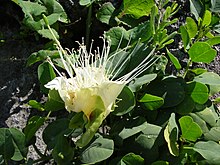Capparis
| Capparis | |
|---|---|
 |
|
| Maiapilo (Capparis sandwichiana) | |
| Scientific classification | |
| Kingdom: | Plantae |
| (unranked): | Angiosperms |
| (unranked): | Eudicots |
| (unranked): | Rosids |
| Order: | Brassicales |
| Family: | Capparaceae |
| Genus: |
Capparis L. |
| Species | |
|
Many, see text |
|
| Synonyms | |
|
Atamisquea Miers ex Hook. & Arn. |
|
Many, see text
Atamisquea Miers ex Hook. & Arn.
Beautempsia Gaudich.
Breynia L.
Linnaeobreynia Hutch.
Pseudocroton Müll.Arg.
Sodada Forssk.
Capparis is a flowering plant genus in the family Capparaceae which is included in the Brassicaceae in the unrevised APG II system. These plants are shrubs or lianas and are collectively known as caper shrubs or caperbushes. Capparis species occur over a wide range of habitat in the subtropical and tropical zones.
Caperbushes are mainly used by humans for their fruit, which are rich in micronutrients. C. spinosa, simply known as caper, yields fruit and more importantly flower buds, which are widely used pickled as a vegetable condiment. The fruit of other species, such as karir (C. decidua), are also used for cooking; C. mitchellii and the Wild passionfruit (the local subspecies of C. spinosa) are well-known bush tucker in Australia. Mabinlang seeds (C. masaikai) are eaten as sweets.
Mabinlang is also used in Traditional Chinese Medicine. Aspalathos, the root of a shrub contained for example in the sacred Ancient Egyptian incense kp.t (kyphi), is sometimes considered to be C. spinosa. Other species have also recorded uses in herbalism and folk medicine; dedicated research is largely lacking however. Mabinlins are sweet-tasting proteins found in Mabinlang seed (and possibly in other Capparis species); at least one of them is highly resistant to heat. The market for mabinlins is not large, but this is mainly due to insufficient supply rather than to lack of demand.
...
Wikipedia
